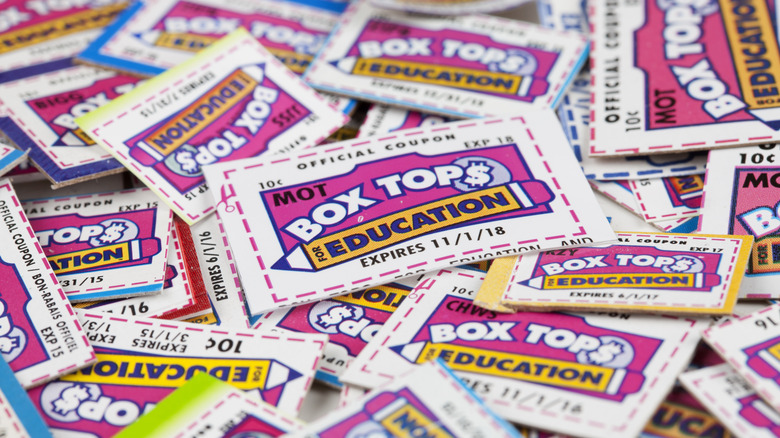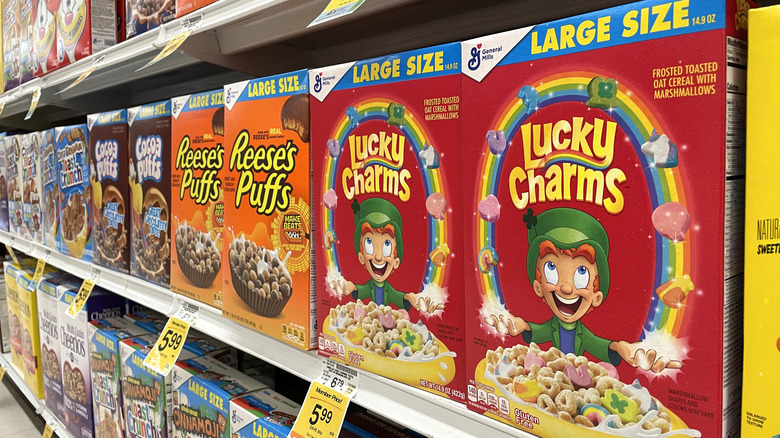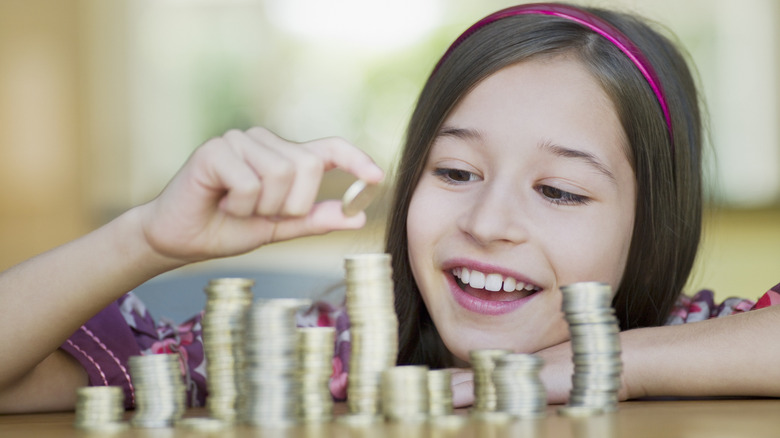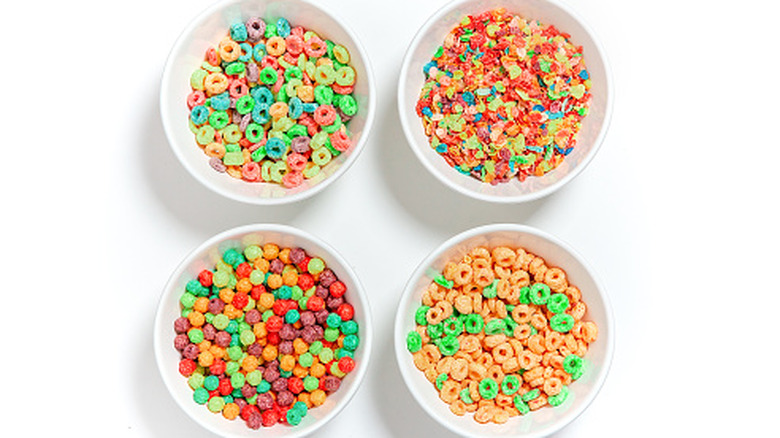Box Tops For Education, 25 Years Later: The Pros And Cons Of Snacking For A Cause
Do you recall the Box Tops for Education logo on all your favorite snack packaging, the little square with a pair of scissors or a pencil in the center? If you grew up in the '90s, it was on your Fruit Roll-Ups and breakfast cereal, packs of granola bars and pizza rolls. In the spirit of back-to-school season, I started wondering about Box Tops for Education, a program that could fairly be called K-8 students' earliest taste of fundraising. The name alone brings back memories of ripping off little pieces of cardboard from snack boxes and saving them in a Ziploc bag to be taken to school.
General Mills launched Box Tops for Education 25 years ago, in 1996. According to a case study by The Council on Foundations, it was a program created "as an alternative to cents-off product couponing." The whole idea was designed as a win-win for kids, their schools, and General Mills as a company, since it pertains to General Mills products and its partner brands (though similar programs exist, like Campbell's Labels for Education, shuttered in 2018 after more than 40 years). From 1996 through the present day, the program has remained available to both public and private schools, kindergarten through eighth grade.
How it works
The process has always been pretty simple: Consumers buy specific General Mills products with the Box Tops logo on them, like Lucky Charms or Cheerios, and then clip off the logo like it's a coupon. Every clipped box top is worth 10 cents toward school funding. Schools apply to be part of Box Tops for Education and designate a coordinator, who was once responsible for gathering all the student-collected box tops (more on that later). The coordinator then filled out a form to submit the box tops to General Mills twice a year by a certain deadline and eventually fielded that coveted General Mills check in return.
On the General Mills side of things, someone had to tally up the box tops. According to Mollie Wulff, Corporate Communications Manager for General Mills, for the first couple decades of the program, the corporation teamed up with an outside processing company that went through and counted out each submitted box top to determine how much money each school was owed.
This snip-and-submit process is exactly what I and many others remember from our grade school days. Begging my mom to buy more Fruit Roll-Ups and wanting to collect more box tops than anyone else in my class was my first real step toward raising money for a cause I cared about. Bringing a baggie of box tops to school was a small gesture, but one whose impact I would be able to see for myself eventually.
But my sense of nostalgia more or less dies there, because I learned that as of 2019, Box Tops for Education has moved its process into the modern age of technology. You can now download a mobile app and, if your school is enrolled in the program, scan your receipts after your purchase. The app identifies products that qualify for Box Tops and automatically adds them to the tally of your school's total earnings. Such a breeze! But like a lot of technology updates, it takes the personal touch out of the process.
Box Tops in the modern era
Today's students won't get the tangible satisfaction of filling up a baggy with all their "hard-earned" box tops and taking it into class for everyone to see. While kids were once the delivery system for the box tops, they effectively don't have to be part of the process at all anymore. However, as Wulff points out, "The program has always really been geared towards parents and families, even though kids are the beneficiaries."
"But I think schools are finding fun and unique ways to celebrate with their student population when they make an investment with their Box Tops dollars," Wulff adds.
And although kids won't be clipping out Box Tops logos anymore, there are more ways to support the program than ever. For example, the app lets just about anyone (maybe a student's relatives or family friends) enroll in a specific school and fundraise using their own receipts.
The app is still early in its rollout, so General Mills is still accepting physical box tops until they expire. However, schools are experiencing some growing pains with the transition. According to a brand-experience manager for Box Tops for Education, school earnings from the program went down by a third in 2020. This drop could be a combination of privacy concerns with the app, problems with the user experience, and the tightening of family snack budgets throughout the COVID-19 pandemic.
The school's Box Tops coordinator role has also changed with the switch to new technology. Instead of having to collect, sort, count, and ship clippings along with proper forms in order to receive payment, the coordinator now serves as more of a cheerleader for the program who encourages the community to participate and demonstrates how to use the app. Considering the intended user-friendliness of the app, though, the coordinator role might become simply symbolic.
How much money has Box Tops For Education raised?
Newfangled process or not, Box Tops for Education has a long history of providing funding to schools. To date, schools have earned $953 million through the program. That figure includes collected clippings, earnings from the app, occasional sweepstakes winnings paid to schools, and annual back-to-school fundraising promotions — essentially any dollars earned by a school via Box Tops throughout the life of the program, according to Wulff.
Nearly a billion dollars raised with box tops? That sounds fantastic, and it is, but it's important to think of it in terms of just how many schools are enrolled in the program, and just how many years the program has been running. As of 2020, just over 80,000 schools participate in the program. On average, the Washington Post reports schools pull in about $750 a year from Box Tops for Education, which is a slightly less impressive number.
The downside of snack-based fundraising
Encouraging kids or their parents to buy more processed snack foods so they can help their school is a bit deceiving. In fact, less than one-third of the products General Mills includes in Box Tops for Education meet national standards for food and beverages sold in schools, according to a 2017 study.
I'm not a nutritionist, and I know that items like Lucky Charms and Hamburger Helper are just fine in moderation, but what kid practices moderation when they're essentially being entered into a race against their classmates to consume the highest amount of these products?
It's also worth remembering that it takes 10 purchases just to earn a whole dollar for one's school, and the cost of qualifying products can range anywhere from $2 to $10, for both food and non-food items. It's likely that these prices alienate a significant portion of the people whom the program is meant to help. Underfunded schools, therefore, can't raise much money encouraging the purchase of name-brand products when their community largely opts for groceries that fit their budget better.
So, after taking a trip down memory lane and doing some additional research, I have to ask: Did we all get bamboozled by a fantastic marketing strategy? Yes, I must conclude that we sort of did. But the money that gets funneled to schools is real, and it will inevitably have some positive impact. So if your love for Fruit Roll-Ups remains, like mine does, consider scanning it into the Box Tops app so that it can do as much good for schools as it can.




